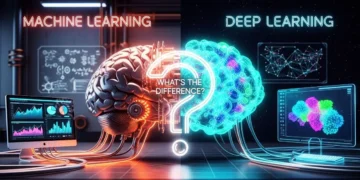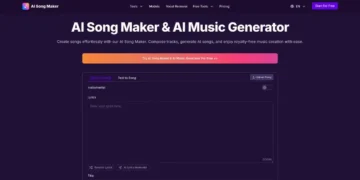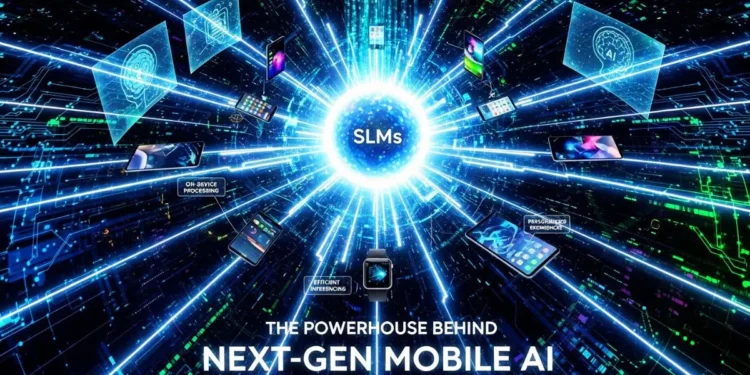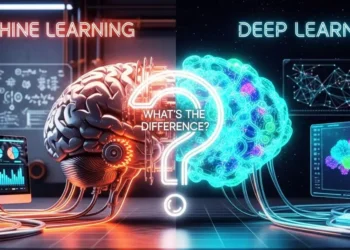In the ever-evolving landscape of artificial intelligence, a quiet revolution is underway—one that promises to bring sophisticated AI capabilities directly into the palm of your hand. While large language models like ChatGPT and Gemini have dominated headlines with their impressive capabilities, a new generation of compact, efficient small language models is rapidly emerging as the true enabler of next-generation mobile AI applications. But what exactly are these streamlined AI powerhouses, and why are they becoming increasingly crucial for our connected world?
Imagine having a virtual assistant that understands your requests instantly, without waiting for a cloud connection. Picture a translation app that works seamlessly in remote areas with no internet access. Envision personalized educational tools that adapt to your learning style while keeping all your data securely on your device. This isn’t a distant future fantasy—it’s the practical reality that SLM AI technology is making possible today.
What are Small Language Models (SLMs)? Understanding the Compact AI Revolution
Small language models are streamlined versions of their larger counterparts, specifically designed to operate efficiently with limited computational resources. While definitions vary, SLMs typically range from a few million to several billion parameters—significantly smaller than the hundreds of billions found in most LLM models . Parameters are the internal variables that a model learns during training, essentially determining how it processes and generates information .
But here’s an important question for you: When you think about AI on your mobile device, what matters more to you—having a model that knows everything about every possible topic, or one that excels at the specific tasks you actually use daily?
The key distinction lies not just in size but in design philosophy. While large language models aim for broad, general knowledge, SLMs prioritize efficiency, specialization, and practical deployment in resource-constrained environments like smartphones, IoT devices, and edge computing systems . This fundamental difference in approach makes SLMs uniquely suited for the mobile-first world we increasingly inhabit.
The Technical Foundation: How SLMs Actually Work
At their core, most small language models employ the same transformer model architecture that powers their larger counterparts . This sophisticated neural network design uses self-attention mechanisms to weigh the importance of different words in a sequence, allowing the model to understand context and generate coherent responses .
The magic happens through several key processes:
Encoders transform input sequences into numerical representations that capture semantic meaning and positional information
Self-attention mechanisms allow the model to dynamically focus on the most relevant parts of the input
Decoders use these representations to generate statistically probable output sequences
What’s particularly fascinating is how developers create these compact powerhouses. Through techniques like knowledge distillation, pruning, and quantization, they’re able to compress massive models into efficient versions that retain much of their original capability while requiring far fewer resources .
SLM vs LLM: Understanding the Critical Differences
When evaluating SLM vs LLM capabilities, it’s essential to look beyond simple parameter counts and understand their fundamental operational differences. Let’s break down the key distinctions:
| Characteristic | Small Language Models (SLMs) | Large Language Models (LLMs) |
|---|---|---|
| Size/Parameters | Millions to a few billion | Hundreds of billions to trillions |
| Computational Requirements | Low (can run on smartphones) | Very high (requires cloud/data centers) |
| Deployment | On-device, edge computing | Cloud-based |
| Cost | Lower operational costs | Significant infrastructure investment |
| Latency | Very low (instant responses) | Variable (depends on network and server load) |
| Domain Expertise | Highly specialized | General knowledge |
| Data Privacy | Enhanced (processing happens locally) | Potential privacy concerns (data sent to cloud) |
Think about your own needs for a moment: Do you typically require an AI that can discuss obscure historical events and generate sonnets in the style of Shakespeare, or would you benefit more from a focused assistant that excels at managing your schedule, drafting work emails, and providing context-aware suggestions throughout your day?
The difference between LLM and SLM extends beyond technical specifications to their very design philosophy. Large language models aim to be jack-of-all-trades, while small language models increasingly follow a master-of-one approach—or more accurately, masters-of-several-key-domains.
Performance and Efficiency: The Surprising Capabilities of Compact Models
You might assume that smaller necessarily means less capable, but recent advancements have challenged this perception. Models like Microsoft’s Phi AI series demonstrate that well-designed SLMs can match or even surpass larger models in specific tasks despite their compact size .
For instance, Microsoft’s Phi-3-mini with 3.8 billion parameters performs competitively against much larger models in reasoning, coding, and mathematical tasks . Similarly, GPT-4o mini showcases performance close to its larger sibling GPT-4o while being significantly more efficient .
The secret lies in several optimization strategies:
Better training data curation: Higher quality, more diverse training datasets
Architectural innovations: More efficient neural network designs
Advanced compression techniques: Sophisticated methods to reduce size without sacrificing capability
The Mobile Revolution: Why SLMs Are Perfect for Smartphones and Edge Devices
The emergence of practical small language models couldn’t come at a better time, as our reliance on mobile devices continues to grow. But what makes SLMs particularly well-suited for mobile environments?
On-Device Processing: Speed and Privacy Advantages
One of the most significant benefits of running a small language model on a mobile phone is the elimination of network latency. When AI processing happens directly on your device, responses become nearly instantaneous—there’s no waiting for data to travel to distant servers and back .
This local processing also provides substantial privacy benefits. Your personal data, conversations, and documents never leave your device, significantly reducing the risk of exposure through data breaches or unauthorized access . For businesses handling sensitive information, this inherent privacy makes SLMs particularly attractive for mobile deployment.
Consider this: Would you feel more comfortable discussing confidential work projects with an AI assistant that processes everything locally, or one that sends your conversations to cloud servers potentially thousands of miles away?
Practical Mobile Applications Transforming User Experiences
Small language models are already enhancing mobile experiences in numerous ways:
Smart Reply and Predictive Text: Advanced suggestions that understand context beyond simple word completion
Voice Assistants: More responsive and capable digital assistants that work offline
Real-time Translation: Instant language translation without internet connectivity
Personalized Content Curation: AI-driven content recommendations that adapt to your preferences
Enhanced Photography: Smarter computational photography that understands scene content
Accessibility Features: Advanced voice control and screen reading capabilities
The beauty of these applications lies in their seamless integration into our daily mobile experiences—often without users even realizing they’re interacting with sophisticated AI systems.
Leading Small Language Models Powering Today’s Mobile AI
The SLM landscape has diversified rapidly, with several standout models demonstrating exceptional capabilities in compact form factors. Let’s explore some of the most influential players:
Microsoft’s Phi Family: The Efficiency Pioneers
Microsoft’s Phi AI series has been instrumental in demonstrating the potential of small-scale models. The Phi-3 family, particularly Phi-3-mini with 3.8 billion parameters, delivers performance that rivals much larger models in reasoning, coding, and mathematical tasks . What’s your guess—how many specialized tasks could a well-designed model of this size handle effectively?
Google’s Gemma: Compact Multimodal Powerhouse
Google’s Gemma models, available in 2B, 7B, and 9B parameter sizes, provide excellent performance while maintaining efficiency . These models are particularly notable for their strong multilingual capabilities and open accessibility through platforms like Google AI Studio and Hugging Face .
Meta’s Llama Series: The Open Source Favorite
Meta’s Llama models have gained significant traction in the open-source community. The Llama 3.2 release offers 1B and 3B parameter variants specifically optimized for edge devices . The quantized versions of these models are more than half their original size and 2-3 times faster, making them ideal for mobile deployment .
Emerging Contenders: SmolLM2 and Specialized Variants
Innovative models like SmolLM2 (1.7B parameters) from HuggingFaceTB demonstrate how specialized training on curated datasets can produce remarkably capable compact models . These specialized foundation models often outperform their generally-trained counterparts on specific tasks despite their smaller size.
Implementing SLMs in Mobile Applications: A Practical Guide
For developers and businesses looking to leverage small language models in mobile applications, several implementation approaches have emerged:
On-Device Deployment Frameworks
Tools like Ollama for PCs and PocketPal for mobile devices have dramatically simplified SLM deployment . These frameworks handle the complexities of model management, memory optimization, and inference acceleration, allowing developers to focus on creating compelling user experiences.
The process typically involves:
Selecting an appropriate model based on performance requirements and device capabilities
Optimizing the model for target hardware using quantization and pruning
Integrating the model with application logic through well-designed APIs
Implementing efficient memory management for smooth operation
Optimization Techniques for Mobile Constraints
Successful mobile SLM implementation requires careful optimization:
Quantization: Reducing numerical precision to decrease model size and accelerate inference
Pruning: Removing redundant parameters to create leaner models
Knowledge Distillation: Transferring knowledge from larger models to compact students
Hardware-Aware Design: Developing models specifically optimized for mobile processors
How Do SLMs Work? The Technology Behind the Power
While they may be smaller, SLMs are built upon the same groundbreaking technology that powers their larger counterparts. Their efficiency comes from intelligent design and a focused training strategy.
Built on a Transformer Model Architecture
At the heart of most modern language models, both large and small, is the transformer model. This architecture, introduced in 2017, revolutionized how AI processes sequential data like text. It uses a mechanism called “self-attention” to weigh the importance of different words in a sentence, allowing it to capture complex relationships and context. SLMs utilize a more streamlined version of this architecture, with fewer layers and parameters, which makes them faster and more lightweight without sacrificing their ability to understand language.
The Importance of High-Quality, Specialized Data
The secret to the success of many top-performing SLMs isn’t just a smaller architecture—it’s a laser-focused approach to data. Instead of feeding the model the entire internet, developers curate smaller, “textbook-quality” datasets. This strategy has two main benefits:
Reduces Training Cost: Less data means less computational power needed for training.
Improves Performance: High-quality, clean, and relevant data allows the model to learn the nuances of a specific domain more effectively, leading to higher accuracy and better performance on its designated tasks. This is a core principle behind models like Microsoft’s Phi AI.
The Rising Stars: Examples of Powerful SLMs
The SLM ecosystem is exploding with innovation. These aren’t just theoretical models; they are powerful tools already being deployed in real-world applications.
Microsoft’s Phi AI: A Textbook Example
Microsoft’s Phi AI family of models demonstrates the power of the “less is more” philosophy. The series includes models like Phi-2 (2.7 billion parameters) and the more recent Phi-3 family (3.8B to 14B parameters). What makes them special is their training on a carefully curated mix of filtered web data and synthetic data designed to teach logical reasoning. The Phi-3-mini variant, with 3.8 billion parameters, delivers performance comparable to much larger models like GPT-3.5 and can run entirely on a mobile device. This is a game-changer for creating sophisticated AI assistants, coding helpers, and other tools that work offline.
SmolVLM: Bringing Vision to Small Models
AI is becoming increasingly multimodal, meaning it can understand more than just text. SmolVLM is a cutting-edge model that redefines what a small model can do by integrating vision capabilities. With only around 2 billion parameters, SmolVLM can analyze and understand images with remarkable efficiency. It achieves this through a clever architecture that combines an efficient vision encoder with a small language model and uses innovative techniques to compress visual data. This opens the door for powerful on-device applications like real-time object recognition, document analysis, and visually-aware chatbots.
The Future of Small Language Models: Trends and Predictions
As small language models continue to evolve, several exciting developments are shaping their trajectory:
Hybrid AI Systems: Combining Strengths
Increasingly, we’re seeing hybrid approaches that leverage both large language models and specialized SLMs . Intelligent routing systems can evaluate queries and direct them to the most appropriate model—using SLMs for straightforward requests while reserving LLMs for complex, unusual, or highly creative tasks .
What if your mobile device could seamlessly switch between local SLMs for most tasks and cloud-based LLMs only when absolutely necessary? How might that balance of efficiency and capability enhance your daily AI interactions?
Specialization and Domain Expertise
The trend toward highly specialized small language models continues to accelerate. Rather than attempting to be all things to all users, developers are creating models fine-tuned for specific domains like healthcare, legal analysis, technical support, and creative writing .
Multimodal Capabilities Expansion
While early SLMs focused primarily on text, newer models like SmolVLM are incorporating multimodal capabilities, enabling understanding and generation across text, images, and eventually audio and video . This expansion will further enhance their utility in mobile contexts where multiple interaction modes are essential.
Challenges and Limitations: The Realistic View of SLM Capabilities
Despite their impressive advances, small language models still face certain limitations:
Narrower Knowledge Base: SLMs have less extensive knowledge than their larger counterparts
Reduced Reasoning Complexity: They may struggle with highly nuanced or multi-step reasoning tasks
Domain Constraints: Performance can degrade outside their training domains
Potential Bias: Like all AI models, they can reflect biases in their training data
The key is recognizing that SLMs aren’t intended to replace LLMs entirely but rather to complement them in contexts where efficiency, privacy, and responsiveness matter most.
Conclusion
The rise of small language models represents a significant maturation in the AI landscape—a shift from pure capability pursuit to practical, sustainable deployment. As these compact powerhouses continue to evolve, they’re poised to become the invisible engines driving increasingly intelligent mobile experiences.
The question is no longer whether small language models are capable enough for real-world applications, but rather how quickly we can integrate them into the mobile ecosystems that have become central to our personal and professional lives. The future of mobile AI isn’t just about what these systems can do—it’s about making advanced capabilities accessible, private, and instantaneous for users worldwide.
As we look ahead, one thing seems certain: The biggest AI innovations might not come from making models increasingly massive, but from making them intelligently compact. And that’s a development that fits perfectly in the palm of your hand.
Frequently Asked Questions (FAQs)
What is the SLM small language model?
A small language model is a compact artificial intelligence model designed to process, understand, and generate human language while requiring significantly fewer computational resources than large language models. SLMs typically range from a few million to several billion parameters and are optimized for deployment in resource-constrained environments like mobile devices and edge computing systems .
What is the difference between LLM and SLM?
The primary difference between LLM and SLM lies in their scale, resource requirements, and specialization. Large language models have hundreds of billions to trillions of parameters, require substantial cloud infrastructure, and excel at general knowledge tasks. Small language models are significantly more compact, can run on devices like smartphones, and are often specialized for specific domains or tasks . SLMs offer advantages in speed, privacy, and cost-efficiency, while LLMs generally have broader knowledge and more advanced reasoning capabilities.
What is a small language model on a mobile phone?
A small language model on a mobile phone is an AI model specifically optimized to run directly on smartphone hardware without requiring constant cloud connectivity. This enables features like instant voice assistants, offline translation, predictive text, and personalized suggestions while keeping user data securely on the device . These models are designed to operate within the computational, memory, and power constraints of mobile devices while delivering responsive AI experiences.
Are small language models the future of AI?
While small language models are unlikely to completely replace their larger counterparts, they are certainly positioned to become the dominant form of AI for consumer applications, mobile devices, and edge computing. Their efficiency, privacy advantages, and cost-effectiveness make them ideal for widespread deployment . The future will likely involve hybrid systems that intelligently distribute tasks between SLMs and LLMs based on complexity and requirements .
Who uses SLMs?
SLMs are used by a diverse range of organizations and individuals, including mobile app developers integrating AI features, businesses deploying specialized assistants, researchers with limited computational resources, IoT device manufacturers, and privacy-conscious organizations that cannot send data to cloud services . As the technology matures, usage is expanding to virtually every sector that can benefit from efficient, specialized AI capabilities.
What are the 4 models of AI?
While AI categorization varies, four fundamental model types include:
Reactive Machines: Basic AI that responds to stimuli without memory (e.g., chess-playing AI)
Limited Memory: AI that can learn from historical data (e.g., most current ML models)
Theory of Mind: Future AI that understands human emotions and mental states
Self-Aware AI: Hypothetical systems with consciousness and self-awareness
Most current small language models fall into the limited memory category, though the field continues to evolve rapidly.
What is a small language model SLM?
A small language model is a compact artificial intelligence system capable of processing, understanding, and generating human language. As the name implies, SLMs are smaller in scale and scope than large language models, with parameter counts ranging from a few million to a few billion rather than the hundreds of billions or trillions found in LLMs . Their compact nature makes them ideal for resource-constrained environments and applications where efficiency and privacy are priorities.
What is a SLM vs LLM?
The distinction between SLM vs LLM encompasses multiple dimensions. Small language models prioritize efficiency, specialization, and deployment in constrained environments, while large language models emphasize broad knowledge, general capabilities, and advanced reasoning . SLMs typically excel in specific domains, offer faster inference, lower costs, and enhanced privacy, while LLMs provide more comprehensive knowledge and better performance on complex, unpredictable tasks .
Is DeepSeek LLM or SLM?
DeepSeek offers both large language models and distilled smaller versions. The main DeepSeek models like V3 and R1 are large language models with 671 billion parameters . However, DeepSeek also provides distilled versions such as DeepSeek-R1-1.5B, which qualify as small language models with 1.5 billion parameters . This dual approach allows users to select the appropriate scale for their specific needs and constraints.
How do SLMs work?
Small language models work using similar underlying technology to large language models, primarily based on the transformer model architecture . They process input text by converting it into numerical representations, using self-attention mechanisms to identify important relationships within the text, and generating outputs through decoder components . SLMs achieve their efficiency through techniques like knowledge distillation, pruning, quantization, and low-rank factorization, which reduce model size while preserving much of the original capability






































